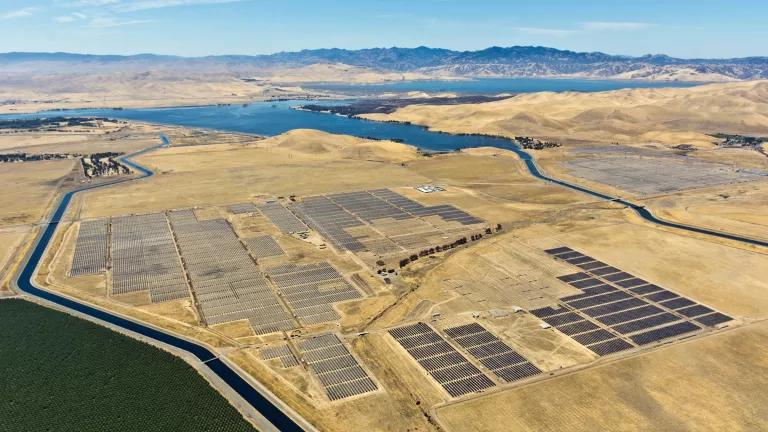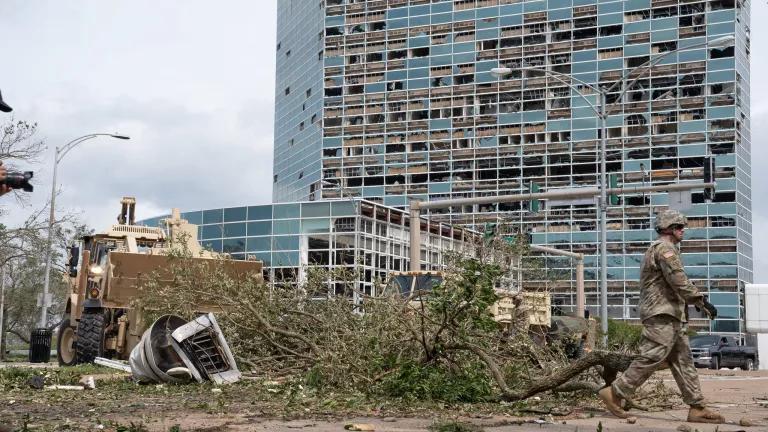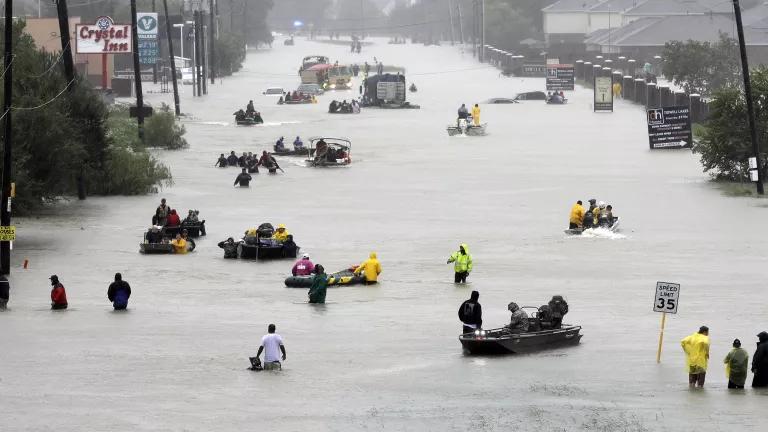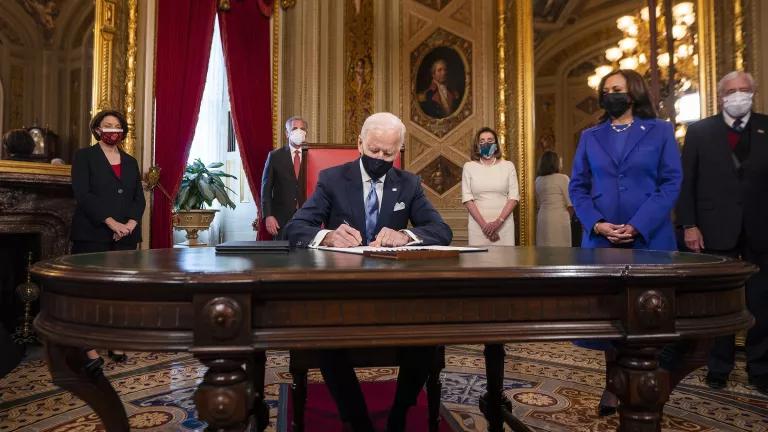Biden to Map Out Strongest Ever U.S. Climate Actions
On Wednesday, President Biden will issue a national call to move away from fossil fuels and toward renewable energy in a way that improves our health, gets our people back to work, and helps build a more just and equitable society.

A solar project under construction near Santa Nella, California
Tomorrow, President Biden plans to map out the strongest U.S. action ever to confront the widening climate crisis, with a comprehensive package of robust federal policies, standards, and investments to set the nation on track to cut its carbon footprint effectively to zero by the middle of this century.
This is a national call to action on the central environmental crisis of our time. It comes not a day too soon.
We’ve got 10 years to cut our carbon footprint in half, the science tells us, to avert the worst of climate catastrophe. While California, New York, and other states have pressed forward with important climate advances, at the national level we just squandered four years, and there’s no time left to waste.
Biden isn’t tinkering around the edges. His vision is to shift the American economy away from the fossil fuels that are driving the climate crisis and transition the country toward cleaner, smarter ways to power our future.
In broad strokes, that means policies and investments to help us become more efficient, get more renewable power from the wind and sun, and modernize our electricity grid and storage systems: commonsense standards to clean up the cars, trucks, and dirty power plants that together account for about two-thirds of the nation’s carbon footprint; protecting public lands, ocean waters, and coastal communities from the dangers and destruction of fossil fuel extraction; safeguarding habitat, fighting species collapse, and increasing the capacity of forests, wetlands, and farms to naturally absorb carbon from the atmosphere and lock it away in healthy soils; and restoring U.S. climate leadership around the world so we become, once again, part of the solution rather than the problem.
It’s an ambitious agenda for a towering task. It’s one reason Biden won the November election by more than 7 million votes. And it complements his urgent work to tame the raging pandemic, get the economy humming again, and address racial injustice and inequity.
The low-income communities and people of color who’ve done the least to contribute to the climate crisis are the very ones suffering a disproportionate share of climate hazard and harm. That’s environmental racism, and addressing it is a core and guiding objective of Biden’s climate action plan.
It will also improve public health by, for example, curbing the warming that aggravates asthma and raises the risk of heat stroke for seniors, farmworkers, and others. Cutting carbon pollution also reduces dangerous air contaminants that contribute to the very kinds of respiratory ailments that can compromise a person’s ability to fight off illnesses like COVID-19. These are the kinds of environmental issues that disproportionately impact the health of people of color and low-income communities. Addressing them helps to advance environmental justice.
The climate action Biden prescribes will do one thing more: create millions of good-paying jobs across a wide swath of the country.
As the pandemic took hold last spring, some 3.4 million Americans were working in clean energy industries—from wind and solar to electric cars—at jobs paying, on average, 28 percent above the median wage. Nearly 540,000 of those jobs are in California, the nation’s clean energy jobs leader, where the sector pays a median wage of $27.49 an hour, 29.2 percent above the statewide median.
Biden’s call for $2 trillion in clean energy investments will put millions more people back to work, sparking exactly the kind of strong, durable, and widespread job growth we need to drive a lasting recovery from the pandemic downturn. And his pledge to direct at least 40 percent of that investment to low-income neighborhoods and communities of color will produce benefits and opportunities to the people on the frontlines of the climate crisis. Congress should get behind this investment for the sake of our economy and our future.

An employee at the National Renewable Energy Laboratory works on a research turbine at NREL’s National Wind Technology Center in Colorado.
Dennis Schroeder/NREL, 53482
Over the past four years, at the federal level, we’ve all but lost sight of what good governance is all about: identifying a national problem, then wedding expertise and political will to develop a remedy that draws on collective resources to serve the public good. That’s what Biden’s climate plan does, as an unyielding deadline for action looms.
We just wrapped up the hottest decade since global record-keeping began in 1880. Last year was essentially tied with 2016 as the hottest year on record, with an average temperature 1.2 degrees Celsius above levels roughly a century ago.
We’re seeing the results all around us: rising seas and record-breaking hurricanes lashing our coastal communities; terrifying windstorms and withering drought devastating our Midwest ranches and farms; and wildfires in California and neighboring states that burned enough land last year alone to cover the state of New Jersey.
Over just the past five years, these kinds of weather and climate disasters have killed nearly 4,000 Americans and done more than $607 billion worth of damage.
All of this, and much more, will get worse, the science tells us, unless we shift gears now, moving away from the dirty fuels of the past and toward the clean energy solutions of the future.
On Wednesday, Biden will sound a national call to do exactly that, in a way that improves our health, gets our people back to work, and helps build a more just and equitable society. That’s the kind of leadership 81 million Americans voted for in November, and that’s what the president’s call for climate action delivers.




